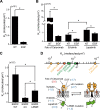Direct visualization of single-molecule membrane protein interactions in living cells
- PMID: 30543635
- PMCID: PMC6307816
- DOI: 10.1371/journal.pbio.2006660
Direct visualization of single-molecule membrane protein interactions in living cells
Abstract
Interactions between membrane proteins are poorly understood despite their importance in cell signaling and drug development. Here, we present a co-immunoimmobilization assay (Co-II) enabling the direct observation of membrane protein interactions in single living cells that overcomes the limitations of currently prevalent proximity-based indirect methods. Using Co-II, we investigated the transient homodimerizations of epidermal growth factor receptor (EGFR) and beta-2 adrenergic receptor (β2-AR) in living cells, revealing the differential regulation of these receptors' dimerizations by molecular conformations and microenvironment in a plasma membrane. Co-II should provide a simple, rapid, and robust platform for visualizing both weak and strong protein interactions in the plasma membrane of living cells.
Conflict of interest statement
The authors have declared that no competing interests exist.
Figures




Similar articles
-
Profiling protein-protein interactions of single cancer cells with in situ lysis and co-immunoprecipitation.Lab Chip. 2019 Jun 7;19(11):1922-1928. doi: 10.1039/c9lc00139e. Epub 2019 May 10. Lab Chip. 2019. PMID: 31073561
-
Analysis of transient membrane protein interactions by single-molecule diffusional mobility shift assay.Exp Mol Med. 2021 Feb;53(2):291-299. doi: 10.1038/s12276-021-00567-1. Epub 2021 Feb 19. Exp Mol Med. 2021. PMID: 33603128 Free PMC article.
-
Visualization of Protein-protein Interaction in Nuclear and Cytoplasmic Fractions by Co-immunoprecipitation and In Situ Proximity Ligation Assay.J Vis Exp. 2017 Jan 16;(119):55218. doi: 10.3791/55218. J Vis Exp. 2017. PMID: 28117799 Free PMC article.
-
Reconstitution of receptor/GTP-binding protein interactions.Biochim Biophys Acta. 1991 Dec 12;1071(4):473-501. doi: 10.1016/0304-4157(91)90007-j. Biochim Biophys Acta. 1991. PMID: 1661159 Review. No abstract available.
-
Analyzing for co-localization of proteins at a cell membrane.Curr Pharm Biotechnol. 2004 Apr;5(2):213-20. doi: 10.2174/1389201043376931. Curr Pharm Biotechnol. 2004. PMID: 15078156 Review.
Cited by
-
EGFR forms ligand-independent oligomers that are distinct from the active state.J Biol Chem. 2020 Sep 18;295(38):13353-13362. doi: 10.1074/jbc.RA120.012852. Epub 2020 Jul 29. J Biol Chem. 2020. PMID: 32727847 Free PMC article.
-
Probing phosphorylation events in biological membranes: The transducer function.Biochim Biophys Acta Biomembr. 2024 Oct;1866(7):184362. doi: 10.1016/j.bbamem.2024.184362. Epub 2024 Jun 15. Biochim Biophys Acta Biomembr. 2024. PMID: 38885782 Review.
-
Improved resolution in single-molecule localization microscopy using QD-PAINT.Exp Mol Med. 2021 Mar;53(3):384-392. doi: 10.1038/s12276-021-00572-4. Epub 2021 Mar 2. Exp Mol Med. 2021. PMID: 33654221 Free PMC article.
-
EGFR Expression in HER2-Driven Breast Cancer Cells.Int J Mol Sci. 2020 Nov 27;21(23):9008. doi: 10.3390/ijms21239008. Int J Mol Sci. 2020. PMID: 33260837 Free PMC article.
-
Tricarboxylate Citrate Transporter of an Oleaginous Fungus Mucor circinelloides WJ11: From Function to Structure and Role in Lipid Production.Front Nutr. 2021 Dec 9;8:802231. doi: 10.3389/fnut.2021.802231. eCollection 2021. Front Nutr. 2021. PMID: 34957193 Free PMC article.
References
Publication types
MeSH terms
Substances
LinkOut - more resources
Full Text Sources
Other Literature Sources
Research Materials
Miscellaneous

